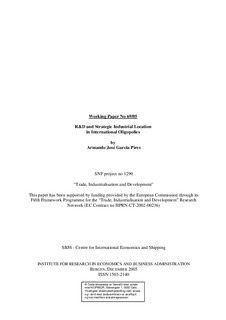| dc.contributor.author | Pires, Armando José Garcia | |
| dc.date.accessioned | 2006-06-21T09:55:08Z | |
| dc.date.available | 2006-06-21T09:55:08Z | |
| dc.date.issued | 2005-12 | |
| dc.identifier.issn | 1503-2140 | |
| dc.identifier.uri | http://hdl.handle.net/11250/166382 | |
| dc.description.abstract | In a spatial economy where Oligopolist firms compete in R&D, it is found that geography affects the innovative behaviour of firms. Notably, international differences in market size conduce to endogenous asymmetries between firms given that firms located in the country with more demand have stronger incentives to invest in R&D. This “R&D linkage” between demand and competitiveness promotes firms to strategically delocalize to the larger country. As a result, a spatial equilibrium arises with only total or partial agglomeration, but never with symmetric dispersion. | en |
| dc.format.extent | 235316 bytes | |
| dc.format.mimetype | application/pdf | |
| dc.language.iso | eng | en |
| dc.publisher | SNF | en |
| dc.relation.ispartofseries | Working Paper | en |
| dc.relation.ispartofseries | 2005:69 | en |
| dc.subject | industrial location | en |
| dc.subject | oligopoly | en |
| dc.subject | R&D investment | en |
| dc.subject | agglomeration | en |
| dc.subject | R&D linkage effects | en |
| dc.title | R&D and strategic industrial location in international oligopolies | en |
| dc.type | Working paper | en |
